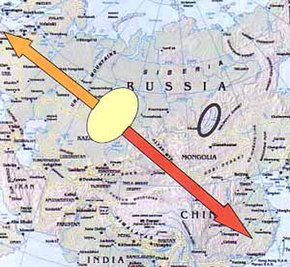
Reverse migration, also called reverse misorientation,[1] is a phenomenon whereby a bird migrates in the opposite direction to that typical of its species during the spring or autumn.[1]
For example, if a bird breeding in central Asia reverses its normal southeasterly migration, as shown by the orange arrow, it will end up in Western Europe instead of South East Asia. This mechanism may lead to birds such as Pallas's leaf warblers turning up thousands of kilometres from where they should be. Keith Vinicombe suggested[2] that birds from east of Lake Baikal in Siberia (circled) could not occur in western Europe because their migration routes were too north–south. Most of these lost young birds perish in unsuitable wintering grounds, but there is some evidence that a few survive, and either re-orient in successive winters, or even return to the same area.[3] Many birds that detour from their regular migration patterns find themselves in adverse wintering circumstances, so a considerable number may not survive. However, there is compelling evidence that a tiny percentage adapt and survive in their unusual wintering locations. In subsequent winters, they may re-orient themselves, eventually making their way back to more favorable environments. Some individuals may even return to the same region in consecutive years, demonstrating migratory birds' adaptability and tenacity.[4]
- ^ a b Thorup, Kasper (October 2004). "Reverse migration as a cause of vagrancy". Bird Study. 51 (3): 228–238. Bibcode:2004BirdS..51..228T. doi:10.1080/00063650409461358. ISSN 0006-3657.
- ^ Vinicombe, Keith; Cottridge, David (1996). Rare birds in Britain and Ireland: a photographic record. London: Collins. p. 192. ISBN 978-0002199766.
- ^ Cite error: The named reference
:3was invoked but never defined (see the help page). - ^ Cite error: The named reference
:8was invoked but never defined (see the help page).